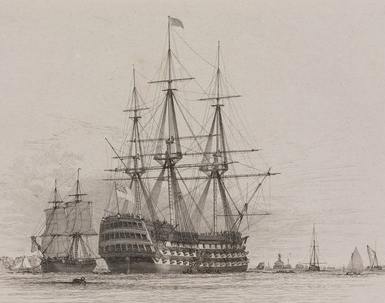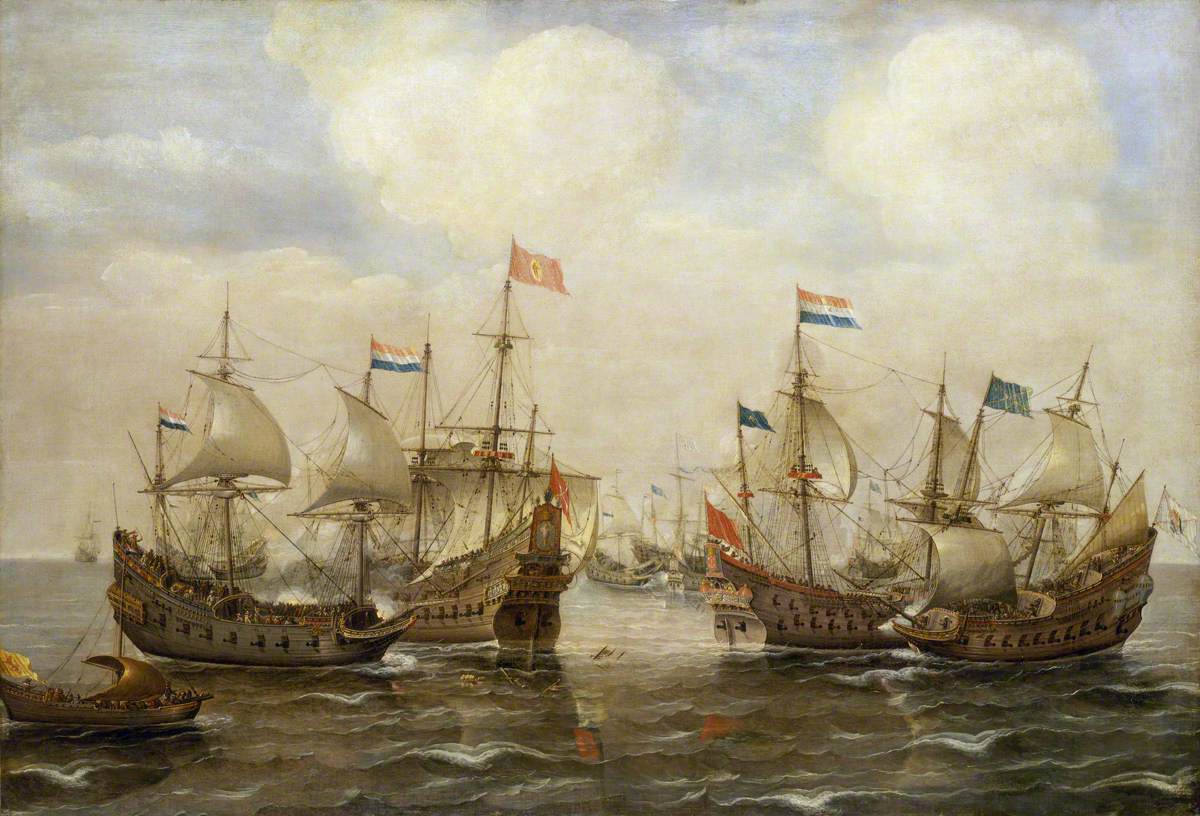By the early decades of the seventeenth century, Barbary corsairs were employing two very different types of ships: oared galleys and square-rigged sailing vessels.
Oared galleys were long, sleek vessels, well suited to conditions in the relatively calm Mediterranean. They were not much good out in the heaving waters of the open Atlantic, though. And since they required slaves to handle the oars, galleys needed to put into port to revictual and resupply quite frequently, making them impractical vessels for long voyages.
We’ll look at oared galleys in another post. Here, we’ll deal with square-rigged ships.
At the beginning of the seventeenth century, English and Dutch ex-privateers found themselves out of commissions because of peace treaties concluded between their governments and Spain. Some of them then turned to outright piracy; some of these took up residence in North African ports. It was they who ended up introducing square-rigged ships to the Barbary corsairs. Captain John Smith (of Jamestown and Pocahontas fame) explained it this way:
“They [the European pirates] became so disjointed, disordered, debauched, and miserable that the Turks and Moors began to command them as slaves and force them to instruct them in their best skill, which many an accursed renegado, or Christian turned Turk, did, till they made those Moors of Barbary as powerful as they be, to the terror of all the Straits. Many times they take purchase in the Atlantic and, yes, sometimes even in the English Channel.”
The “best skill” the Europeans instructed the indigenous Barbary corsairs in was how to build, sail, and navigate European-style square-rigged sailing ships. Once the corsairs had mastered the use of these new (to them) vessels, they burst out of the confines of the Mediterranean and, with their numbers swelled by the influx of northern European renegados, launched a new era of Atlantic raids.
Most people have a general sense of what these seventeenth century European square-rigged sailing ships looked like. The illustration above depicts several of them, each seen from a slightly different angle. Notice the generic similarities. They are all somewhat tubby looking vessels with a high stern and a beaky prow; they all have three masts and a bowsprit, with square sails on the fore and main masts and the bowsprit (the bowsprit sails aren’t shown in the illustration), and a lateen (triangular) sail on the mizzen (the most rearwards) mast; all are armed (the ones in the illustration are warships), with one or two decks of cannon along the sides. This was a standard design, and many seventeenth century ships followed it.
Warships tended to be larger and were better armed than merchant ships. Their purpose, after all, was to be a fighting ship. It was not until the eighteenth century, though, that the great ships of the line came into their own—ships like the famous HMS. Victory, launched in 1765, which was over two hundred feet long and had three gun decks housing more than 100 cannon. In the early seventeenth century, the evolutionary process that brought such impressive vessels into being was only just getting underway. The largest warships of that time were a little over half the size of the Victory, though nearly as well armed. They could have crews of as many as 500 (made up of sailors, soldiers, and gunners), depending on the size and armament of the ship.

Merchant ships were mostly smaller vessels. The purpose of a merchant ship was to carry merchandise at a profit. The larger the ship, the more money and time had to be invested in its construction and maintenance; the cost of building a very large ship was so great that only a government, or the very wealthiest of merchants, or a merchant corporation could acquire the necessary capital. Very large merchant ships might have been able to transport very large cargoes, but they also would have had to return very large profits indeed to make their construction a worthwhile investment. Smaller vessels requiring less initial outlay could still return decent profits. They could also enter smaller harbors and navigate shallower waters, making them more versatile. And they required far less crew—merchant crews were typically between 10 and 30. Moreover, given the uncertainty of long sea voyages, it made sense for merchants to invest in the construction of several lesser vessels rather than one large one. If a merchant had a fleet of modest-sized ships, losing one at sea was a catastrophe that could be survived if the other ships returned successfully. All this meant that, with some exceptions—notably the great treasure galleons the Spanish sailed to and from the New World and the vessels known as the Dutch East Indiamen that carried cargo to and from the East Indies—the really large ships were mostly war ships.
The same constraints that made it impractical for merchants to own and operate very large ships also applied to Barbary corsairs. Building a very large ship could be ruinously expensive. Trying to capture one on the open sea was a risky enterprise, and maintaining and crewing one very expensive. Barbary corsairs also had another constraint. Some of the North African harbors were quite shallow, and large ships had too deep a draft (the bottom of the hull lay too deep in the water) to be able to enter them. Also, since Barbary corsairs preyed on merchant ships rather than warships—for obvious reasons—they had no tactical need to operate huge ships. Smaller ships were also fast and maneuverable, a trait Barbary corsairs (and privateers and pirates in general) valued greatly. So Barbary corsairs typically used more modestly sized vessels.
See the next post in this Corsair Ships: Square-Rigged Vessels series (“Corsair Ships: Square-Rigged Vessels – Part 2”) for details on the dimensions of such modestly sized square-rigged ships.
 The Travels of Reverend Ólafur Egilsson
The Travels of Reverend Ólafur Egilsson
The story of the Barbary corsair raid on Iceland in 1627
Amazon listing